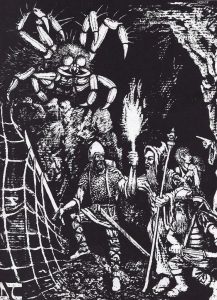
So don’t tell her she looks exactly like the first cat of the emperor of Japan.
Here's the teenage emperor of Japan in the 9th century bragging about his cat, the first recorded instance of cats in Japan. pic.twitter.com/gYnM114Jgn
— Shaenon K. Garrity (@shaenongarrity) September 3, 2021
I was going to take a photo of her to demonstrate how much alike they are, but I just noticed that we’ve been adapting the house to suit her. She has a strong preference for resting on black surfaces, so we’ve been putting down black blankets for her to reign from. I’ve got a black backpack — if I leave that on the floor I’ll come back to find her nesting there. We’ve been able to control where she sleeps in our bedroom to a small degree with a black cloth in a corner. You try taking a picture of a cat whose color is like the deepest ink, who likes to disappear at night.
Wait a minute — why is this cat acting like a ninja in our home? What is she scheming?
But it’s so intuitive! The idea that the less people know, the more they have an unwarranted confidence that they know more than they do, seems to explain so much. There is now evidence that the Dunning-Kruger Effect is an artifact.
The two papers, by Dr. Ed Nuhfer and colleagues, argued that the Dunning-Kruger effect could be replicated by using random data. “We all then believed the [1999] paper was valid,” Dr. Nuhfer told me via email. “The reasoning and argument just made so much sense. We never set out to disprove it; we were even fans of that paper.” In Dr. Nuhfer’s own papers, which used both computer-generated data and results from actual people undergoing a science literacy test, his team disproved the claim that most people that are unskilled are unaware of it (“a small number are: we saw about 5-6% that fit that in our data”) and instead showed that both experts and novices underestimate and overestimate their skills with the same frequency. “It’s just that experts do that over a narrower range,” he wrote to me.
Then I have to rethink who it applies to. We’re so used to pointing at stupid people doing stupid things and explaining it as Dunning-Kruger in action, and it’s not.
The most important mistake people make about the Dunning-Kruger effect, according to Dr. Dunning, has to do with who falls victim to it. “The effect is about us, not them,” he wrote to me. “The lesson of the effect was always about how we should be humble and cautious about ourselves.” The Dunning-Kruger effect is not about dumb people. It’s mostly about all of us when it comes to things we are not very competent at.
Wait wait wait. So I may have been a victim of the Dunning-Kruger Effect when I thought I knew what the Dunning-Kruger Effect was about? Dang. Well, that was a good solid punch in the balls to start my morning. But then, it’s always good to rethink your assumptions and reconsider your ideas, so thank you very much may I have another?
Are there dumb people who do not realize they are dumb? Sure, but that was never what the Dunning-Kruger effect was about. Are there people who are very confident and arrogant in their ignorance? Absolutely, but here too, Dunning and Kruger did not measure confidence or arrogance back in 1999. There are other effects known to psychologists, like the overconfidence bias and the better-than-average bias (where most car drivers believe themselves to be well above average, which makes no mathematical sense), so if the Dunning-Kruger effect is convincingly shown to be nothing but a mirage, it does not mean the human brain is spotless. And if researchers continue to believe in the effect in the face of weighty criticism, this is not a paradoxical example of the Dunning-Kruger effect. In the original classic experiments, students received no feedback when making their self-assessment. It is fair to say researchers are in a different position now.
Wait, what, so maybe I’m not afflicted with Dunning-Kruger? OK, I need to get out of the house and take a walk now.
Someone sent me a link to this page about using spiders in Dungeons & Dragons…as monsters. I am offended!
That’s right those creepy crawly bitey little buggers with all the legs and all the eyes. I hate them IRL [OFFENDED!], and will terminate any that cross over the agreed upon barrier into my home [<gasp> OFFENDED!]. Its a feeling alot of folks the world over share and that is easily exploited for your tabletop game. Which I suggest doing. Its amazing. So here we go – using spiders to torture your players in the best and most memorable ways.
First we have to establish a few things, the biggest of which are the types of spiders found in the game that can be used. Most people assume we mean either the tiny version or the giant version. There is however so~ many spiders that are all canon in 5e so don’t be afraid to mix and match them up to create more diverse encounters. For this blog we will just be talking about spiders not Drieders or spider demons, though I think those are also great things to add to the mix to spice it up. Below is just a quick list of those that can be found in the books. These are create starting points for an easy mix up to the normal spider.
- Spider Swarm
- Spider
- Giant Spider
- Giant Wolf Spider
- Phase Spider
All right, if ever I were a Dungeon Master, first thing I’d do is replace all the player character races with that list. That’ll torture the players! Then I’d expand the list with more species of arachnids, and replace the Monster Manual with the Player’s Handbook.
"I wasn't a big fan of 3 or Salvation, so I'm trying to resist getting my hopes up too much for Dark Fate, but it's hard. I'm just a sucker for humans and robots traveling through time to try to drive trucks into each other, apparently."
Also, Macgruber.



